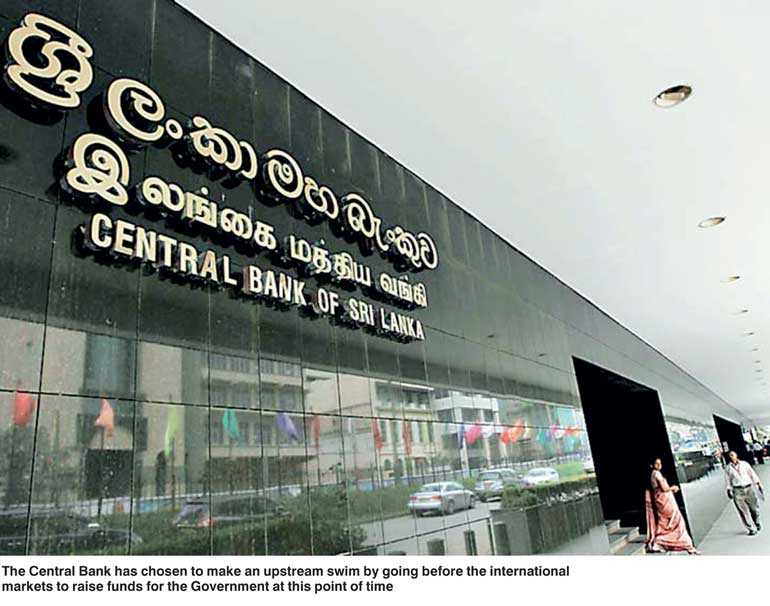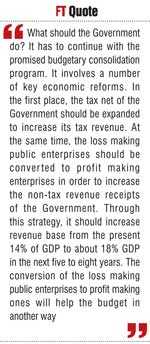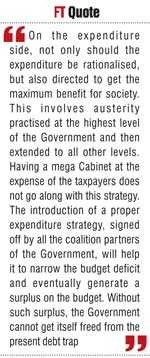Sunday Dec 15, 2024
Sunday Dec 15, 2024
Tuesday, 17 April 2018 00:57 - - {{hitsCtrl.values.hits}}

Issue of sovereign notes
The Central Bank has brought $ 2.5 billion to the country by issuing Sri Lanka Government Sovereign but ‘Senior Unsecured Notes’ in the international markets (available at: https://www.cbsl.gov.lk/en/news/the-democratic-socialist-republic-of-sri-lanka-us-dollars-2.5-billion-international-sovereign-bond-offering ).
‘Senior’ means that in the event of a general default of foreign loans by Sri Lanka, the investors concerned will get priority over its other creditors. This is of course not materially significant since, if a country had made a general default, any recovery would involve protracted international litigation similar to the recent experiences in Argentina. Since a country does not have means of repayment, such litigations are likely to lead nowhere. In most cases, behind the courts, the creditors are forced to reschedule or write off the claims they have on their borrowers.
‘Unsecured’ means that there is no specific collateral supporting these notes. Therefore, the investors have to rely on Sri Lanka’s future economic potential, capacity to repay and size of the net foreign exchange flows to assure the recovery of the money they have lent to the country. If all these things become sour, so are the notes they hold.
Hence, in the international credit markets, it is the borrowers’ market and not that of lenders.
 Risk premium is not unwarrantedly high
Risk premium is not unwarrantedly high
A half of those notes has been for five years, while the other half for 10 years. The bank had expected the prospective investors to bid for these notes at a price guide of 6% for five-year notes and 7% for 10-year notes.
However, by the time of the close of the books in New York, there had been a good interest by investors to compel the issue managers to cut the rates by 25 basis points or a quarter of one percent. Accordingly, the coupon rate at which the investors would be remunerated by Sri Lanka annually happened to be 5.75% for five-year notes and 6.75% for 10-year notes.
Given an average London Interbank Offered Rate or LIBOR of 2.46% for the benchmark six-month offshore dollars, Sri Lanka has agreed to pay a risk premium of 3.29% to 4.29% to investors. Sri Lanka’s credit rating has always been low – below investment grade at B1 or B+ – indicating a high probability of sovereign loan default. Hence, the above risk premia are not unduly high.
It is a note that has been issued
The present note issue differs from previous bond issues.
According to the Central Bank press release, they have not been and will not be, registered under the US Securities Laws or under any such laws pertaining to different US states. Since they are private placements done outside laws of the United States, there has not been any prospectus issued by Sri Lanka to educate the prospective investors of the borrowing in question.
The Central Bank has not mentioned whether they would be registered in any other jurisdiction such as London or Singapore. Hence, any transfer of the ownership before maturity should be done through private negotiation. This is a good sign since a Government which had been very critical of direct placements in the case of domestic Treasury bonds has now come to terms with the market realities.
The Central Bank has cut down the issue costs significantly by not registering with US authorities and issuing a prospectus. The underlying rationale is that if lenders are not worried, why should the bank incur an additional cost for the issue of notes?
Successfully swimming the upstream
The bank has indeed chosen to make an upstream swim by going before the international markets to raise funds for the Government at this point of time. That is because the country had been saddled with three unfavourable developments that took place in March and early April, making it risky for the country to test its borrowing powers in the international markets.
The first happened to be the unwarranted attack on the minority Muslim community in certain parts of the country. The second was the hopeless growth numbers amounting to 3.1% for 2017 released by the country’s official statistics bureau, namely, Census and Statistics Department. The third was the political uncertainty created by the No-Confidence Motion or NCM presented in Parliament against the Prime Minister Ranil Wickremesinghe. Though he was able to defeat it in Parliament, the country is still not free from the political instability created by it.
But the bank and the Government did not have a choice in this regard. Sri Lanka’s foreign debt repayment obligations during the next 12-month period will amount to $ 6.3 billion. Of this, the country should be ready with $ 1.7 billion to meet the obligations in the next three month period. However, the free foreign exchange reserves owned by Sri Lanka, after taking out the non-liquid gold reserves, amounted to just $ 6.3 billion at end March 2018.
Hence, without a massive amount of foreign exchange inflow to the country, it would not be possible to repay the foreign debt without compromising the free market economy system being followed by the country since 1978. Thus, there was no choice but to seek foreign funding by way of an issue of Sovereign Notes in the market.
 The issue of the first sovereign bond
The issue of the first sovereign bond
Sri Lanka has made a name in the international bond markets as a borrower ever since it made its maiden entry to the market Sin 2007. But the circumstances which compelled it to go before the international bond investors for funds in that year are quite similar to those of today. The country was in the middle of Ealam War IV resulting in a heavy haemorrhage of foreign exchange to meet the voracious appetite for weapons by armed forces.
China, the main weapons supplier, had given Sri Lanka only three months’ credit which was initially met by Bank of Ceylon out of its own resources. But, its coffers had to be filled if it was to continue to finance such weapon imports.
There was no country to help Sri Lanka by way of even a hard loan; the Government out of desperation dispatched the Central Bank Governor Ajith Nivard Cabraal to Libya to solicit help, but Mohammed Gaddafi, supposed to be a friend of the former President, sent him back empty handed.
In the meantime, official foreign exchange reserves which were available to the Government to meet any urgent requirement fell below $ 2.8 billion and the country’s oil bill was much more than that. The country had to choose either the free market economy system or the continuation of war efforts. But the likely option was to stick to both since either choice would have been immensely costly.
Hence, Sri Lanka decided to raise funds from the international capital markets by making its maiden issue of sovereign bonds. The amount was small – only $ 500 million compared to $ 3 to 4 billion issued today – but even it was quite a challenge due to two reasons.
One was that Sri Lanka did not have a name as a borrower and it had to create a name. The other was the open campaign launched by LTTE friendly sections in the globe against Sri Lanka. There were even demonstrations in front of both the London and Colombo offices of the lead issue manager, HSBC.
Thus, the Sri Lanka’s road show team led by Governor Cabraal made an arduous journey around the globe – visiting all the major financial centres, namely, Singapore, Hong Kong, Tokyo, Frankfurt, London, San Francisco, Boston and New York – to canvass with the prospective investors.
There were more than 45 meetings held within a space of five to six days. By the time the books were closed in New York, the team was totally exhausted, but it managed to raise $ 500 million against all the odds.
The continued need for external borrowings
This was the story of Sri Lanka’s initial entry to global financial markets done out of desperation.
That initial borrowing could be justified on the ground that if it were not made, the country’s future would have been different with its armed forces, starved of the needed weapons, being required to fight against the well armed LTTE.
This was averted by the Central Bank by supplying foreign exchange to the market continuously, while maintaining the free market economy system intact. Its attempt at enlisting the support of the Sri Lankan Diaspora not sympathetic to LTTE too ended up in failure.
The teams dispatched to North America, the UK, Europe, Middle East and the Oceania too came back practically empty handed. Hence, Sri Lanka had to raise foreign loans from commercial sources to keep the war efforts and the economy going.
Tapping the external commercial markets
However, these borrowings were not expected to be annual exercises. But in practice, that was what they turned out to be. Sri Lanka, instead of putting its house in order, chose to make use of this newly built foreign money pipeline liberally. Hence, year after year, it tapped the international financial markets and every time when it did so, it was by ever increasing amounts.
Then, to repay the previous loans, it had to borrow more. The result was the ever-increasing foreign debt stock, the major component of which consisted of borrowings made on commercial terms. Accordingly, the commercial and non-concessionary component of the external debt stock which stood at 4% in 2005 increased to 50% by 2013.
The risks faced by the country due to the ballooning of the commercial borrowings were brought to the notice of the top policy makers of the country by this writer in an article published in 2014 in this series (available at: http://www.ft.lk/columns/sri-lankas-external-debt-sustainability-complacency-based-on-incomplete-analysis-may-be-the-worst-en/4-297680 ). However, instead of taking cue from the message, the Central Bank chose to shoot the messenger resulting in a series of subsequent exchange of views between the Bank and this writer.
The end result of this imprudent external borrowing by the Government was the substantial increase in the country’s external borrowings which Minister of Finance, Mangala Samaraweera, referred to, using a metaphor, as bigger than the garbage dump at Meetotamulla.
However, the present Government is also not off the hook, when it comes to this charge. During the first two years of its administration, it also resorted to commercial and non-concessionary borrowings increasing the ratio to 60% by the end of 2016.
 A debt trap
A debt trap
Sri Lanka is now caught up in a debt trap as also pronounced by the top Government leaders from time to time. It has always been the situation in the last few decades that the Government had to borrow in order to repay the principal and pay interest.
Hence, the public debt stock increased both in absolute terms and as a ratio of GDP. The gravity of the problem is seen in 2018, 2019 and 2020. In all these three years, the total public debt repayment obligations of the Government are estimated to exceed the projected Government revenue.
What it means is that in the short to medium term, there is no choice for the Government except continuing with borrowing, both domestic and external.
Should not postpone budgetary consolidation efforts
But what should the Government do? It has to continue with the promised budgetary consolidation program. It involves a number of key economic reforms. In the first place, the tax net of the Government should be expanded to increase its tax revenue.
At the same time, the loss making public enterprises should be converted to profit making enterprises in order to increase the non-tax revenue receipts of the Government. Through this strategy, it should increase revenue base from the present 14% of GDP to about 18% GDP in the next five to eight years. The conversion of the loss making public enterprises to profit making ones will help the budget in another way.
At present, the losses of these enterprises are absorbed by the Government in order to prevent them from being qualified by auditors and allow them to continue to have access to bank borrowings. They are unscheduled expenditure items falling on the budget. If they make profits, the Government can not only get additional tax revenue but also earn dividends.
During the first three years of the present Government, no such reform program was undertaken though it had always been on its agenda. This should be the top priority of the Government in the next two-year period.
Rationalise the expenditure
On the expenditure side, not only should the expenditure be rationalised, but also directed to get the maximum benefit for society. This involves austerity practised at the highest level of the Government and then extended to all other levels.
Having a mega Cabinet at the expense of the taxpayers does not go along with this strategy. The introduction of a proper expenditure strategy, signed off by all the coalition partners of the Government, will help it to narrow the budget deficit and eventually generate a surplus on the budget. Without such surplus, the Government cannot get itself freed from the present debt trap.
Thus, the raising a foreign sovereign loan is a small gain. The Government should not savour in that. Instead, it should go for the required economic and budgetary reforms in order to fix the currently ailing economy.
(W.A. Wijewardena, a former Deputy Governor of the Central Bank of Sri Lanka, can be reached at [email protected].)